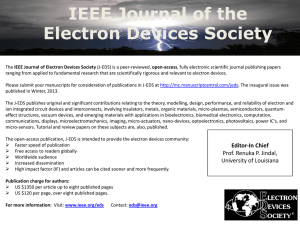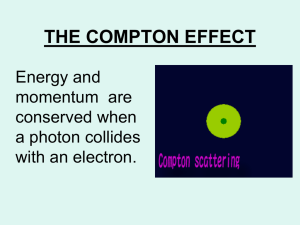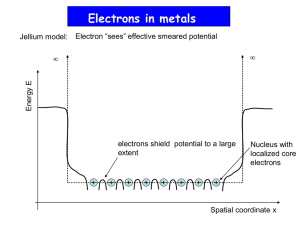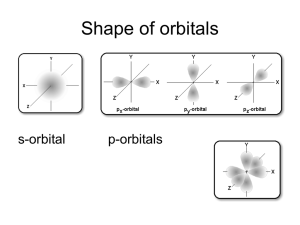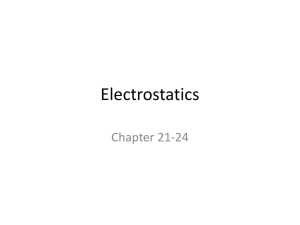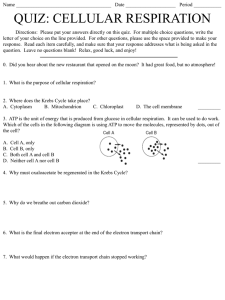HU-IAS Tutorial
advertisement
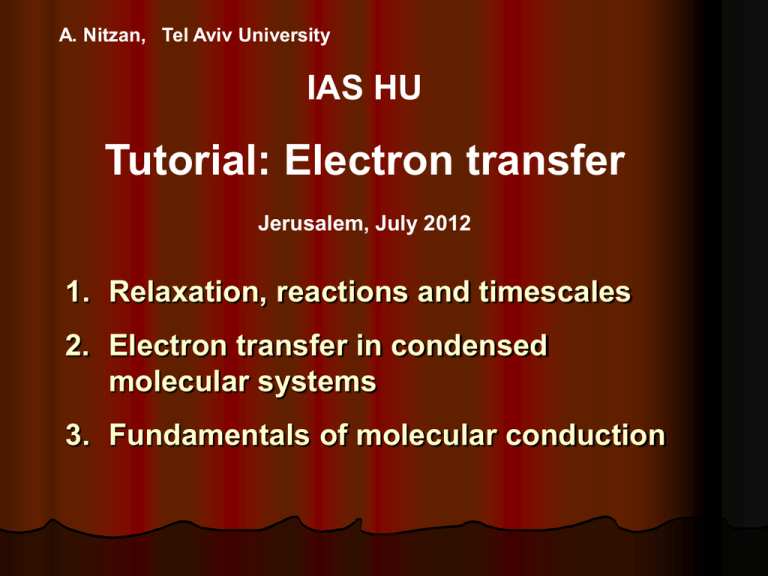
A. Nitzan, Tel Aviv University
IAS HU
Tutorial: Electron transfer
Jerusalem, July 2012
1. Relaxation, reactions and timescales
2. Electron transfer in condensed
molecular systems
3. Fundamentals of molecular conduction
IAS Workshop 2012
(1) Relaxation and reactions in
condensed molecular systems
•Timescales
•Relaxation
•Solvation
•Activated rate processes
•Low, high and intermediate
friction regimes
•Transition state theory
•Diffusion controlled reactions
The importance of timescales
Molecular processes in condensed
phases and interfaces
Molecular timescales
•Diffusion
Electronic 10-16-10-15s
•Relaxation
Vibraional period 10-14s
•Solvation
Vibrational
xxxxrelaxation 1-10-12s
•Nuclear rerrangement
•Charge transfer (electron and
xxxxxxxxxxxxxxxxproton)
•Solvent: an active spectator –
energy, friction, solvation
Diffusion D~10-5cm2/s
10nm
10-7 - 10-8 s
Chemical reactions
xxxxxxxxx1012-10-12s
Rotational period 10-12s
Collision times 10-12s
Frequency dependent friction
i
iif t t
ˆˆ (0)ˆ ~ e 1 / D
iif if F
tˆˆ( tˆ) F
kkf i ~~~ dte
te
F (F
t )(Ft )(0)
constant
F (0)
ff
T
ddte
ii
T
t
T
MARKOVIAN LIMIT
WIDE BAND
APPROXIMATION
1
D
Molecular vibrational relaxation
Relaxation in the X2Σ+ (ground electronic state) and A2Π (excite electronic
state) vibrational manifolds of the CN radical in Ne host matrix at T=4K,
following excitation into the third vibrational level of the Π state. (From V.E.
Bondybey and A. Nitzan, Phys. Rev. Lett. 38, 889 (1977))
Dielectric solvation
C153 / Formamide (295 K)
q=0
Relative Emission Intensity
CF3
q=+e
Born solvation energy
Emission spectra of
a
b
q=+e
N
O
O
c
Coumarin 153 in
q2
1
formamide at different
1 1 2eV (for a charge)
2a s
times. The timesshown
here are (in order of
increasing peakwavelength) 0, 0.05, 0.1,
0.2, 0.5, 1, 2, 5, and 50 ps
(Horng et al, J.Phys.Chem.
450
500
99, 17311 (1995))
550
Wavelength / nm
600
“real” solvation
“Newton”
dielectric
The experimental solvation
function for water using sodium
salt of coumarin-343 as a probe.
The line marked ‘expt’ is the
experimental solvation function
S(t) obtained from the shift in the
fluorescence spectrum. The other
lines are obtained from
simulations [the line marked ‘Δq’
–simulation in water. The line
marked S0 –in a neutral atomic
solute with Lennard Jones
parameters of the oxygen atom].
(From R. Jimenez et al, Nature
369, 471 (1994)).
Electron solvation
C153 / Formamide (295 K)
Relative Emission Intensity
CF3
450
N
500
550
O
O
600
The first observation of hydration
dynamics of electron. Absorption
profiles of the electron during its
hydration are shown at 0, 0.08, 0.2,
0.4, 0.7, 1 and 2 ps. The absorption
changes its character in a way that
suggests that two species are
involved, the one that absorbs in the
infrared is generated immediately
and converted in time to the fully
solvated electron. (From: A. Migus, Y.
Gauduel, J.L. Martin and A. Antonetti,
Phys. Rev Letters 58, 1559 (1987)
Wavelength / nm
Quantum solvation
(1) Increase in the kinetic energy (localization) – seems NOT to affect
dynamics
(2) Non-adiabatic solvation (several electronic states involved)
Activated rate processes
B
EB
0
reaction
coordinate
KRAMERS THEORY:
Low friction limit
High friction limit
Transition State
theory
k
0 J B e EB / kBT
k 4 DR
kBT
(action)
0 B EB / kBT
B
k
e
kTST
2
0 EB / kBT
kTST
e
2
Effect of solvent friction
TST
A compilation of gas and liquid phase data showing the turnover
of the photoisomerization rate of trans stilbene as a function of
the “friction” expressed as the inverse self diffusion coefficient of
the solvent (From G.R. Fleming and P.G. Wolynes, Physics Today,
1990). The solid line is a theoretical fit based on J. Schroeder and
J. Troe, Ann. Rev. Phys. Chem. 38, 163 (1987)).
The physics of transition state rates
B
Assume:
EB
(1) Equilibrium in the well
0
reaction
coordinate
(2) Every trajectory on the barrier that goes out makes it
kTST d v v P ( x B , v ) v f P x B
0
d vv e
0
dv e
12 mv 2
12 mv 2
1
2 m
P ( xB )
0 EB
e
2
exp E B
dx exp V ( x )
EB
m02 E B
e
2
The (classical) transition state
rate is an upper bound
EB
reaction
coordinate
•Assumed equilibrium in the well – in reality
population will be depleted near the barrier
•Assumed transmission coefficient unity above
barrier top – in reality it may be less
Quantum considerations
2
1
a
b
1
R*
R*
diabatic
Adiabatic
k dR R P ( R , R )Pba ( R)
*
0
1 in the
classical case
IAS Tutorial 2012
(1) Relaxation and reactions in
condensed molecular systems
•Timescales
•Relaxation
•Solvation
•Activated rate processes
•Low, high and intermediate
friction regimes
•Transition state theory
•Diffusion controlled reactions
IAS Tutorial 2012
(2) Electron transfer
processes
•Simple models
•Marcus theory
•The reorganization energy
•Adiabatic and non-adiabatic
limits
•Solvent controlled reactions
•Bridge assisted electron transfer
•Coherent and incoherent
transfer
•Electrode processes
Theory of Electron Transfer
Rate – Transition state theory
kTST d v v P ( x B , v ) Pab v
0
Boltzmann
Transition
Activation
probability
energy
Electron transfer in polar media
•Electrons are much faster than nuclei
• Electronic transitions take place in fixed nuclear
configurations
• Electronic energy needs to be conserved during the
change in electronic charge density
q=0
a
Electronic
transition
q=+e
q=+e
b
c
Nuclear
relaxation
Electron transfer
q=0
q=1
q=1
q=0
Nuclear
motion
Nuclear
motion
q=0
q=1
q=1
q=0
Electron transition takes place in unstable nuclear
configurations obtained via thermal fluctuations
Electron transfer
a
b
energy
EA
Ea
E
Eb
Xa
Xtr
Xb
Solvent
polarization
coordinate
Transition state theory of electron
transfer
Adiabatic and non-adiabatic ET processes
E
Landau-Zener
problem
E2(R)
Ea(R)
k dRR P ( R* , R ) Pba ( R )
Vab
0
2
2 | Va ,b |
Pba ( R) 1 exp
R
F
R R*
Eb(R)
E1(R)
*
R
t=0
R
t
k NA
K
2
| Va ,b |2
F
e EA
R R*
(For harmonic diabatic surfaces (1/2)KR2)
Electron transfer – Marcus theory
(0) (0)
qA qB
(1) (1)
q=0q A qB
q=1
D 4
E D 4 P
P Pe Pn
e 1
Pe
E
4
s e
Pn
E
4
q=0
D sE
(0)
(1)
(1)
q(0)
q
q
q
B
B
A
A
q=1
q=0
We are interested in changes in solvent
configuration that take place at
constant solute charge distribution
They have the following characteristics:
(1) Pn fluctuates because of thermal
motion of solvent nuclei.
q=1
q=1
q=0
(2) Pe , as a fast variable, satisfies the
equilibrium relationship
(3) D = constant (depends on only)
Note that the relations E = D-4P;
P=Pn + Pe are always satisfied per
definition, however D sE. (the latter
equality holds only at equilibrium).
Electron transfer – Marcus theory
(0) (0)
qA qB
q=0
q=0
q=1
q=1
(0)
(1)
(1)
q(0)
q
q
q
B
B
A
A
(1) (1)
q A qB
q=1
q=1
Free energy
associated with a
nonequilibrium
fluctuation of Pn
q=0
q=0
0
(0)
q(0)
q
A B
1
(1) (1)
q A qB
q
“reaction coordinate” that
characterizes the nuclear
polarization
The Marcus parabolas
q 0 q ( 1 0 )
Use q as a reaction coordinate. It defines the state of the
medium that will be in equilibrium with the charge
distribution q. Marcus calculated the free energy (as
function of q) of the solvent when it reaches this state in the
systems q =0 and q=1.
q0
2
W0 (q ) E0 q
q1
W1 (q ) E1 1 q
1
1 1
1
1
e s 2 RA 2 RB RAB
2
q
q
2
Electron transfer: Activation energy
Wa (q ) Ea q 2
Wb (q ) Eb 1 q
a
2
b
energy
EA
Ea
E
Eb
[( Eb Ea ) ]2
EA
4
1
1 1
1
1
e s 2 RA 2 RB RAB
qa=0 q
2
q
tr
qb=1
Reorganization
energy
Activation energy
Electron transfer: Effect of Driving
(=energy gap)
Experimental confirmation of the
inverted regime
Marcus papers
1955-6
Miller et al,
JACS(1984)
Marcus Nobel
Prize: 1992
Electron transfer – the coupling
2
ket ~ Vab e
Eab
4 kBT
• From Quantum Chemical Calculations
•The Mulliken-Hush formula VDA
• Bridge mediated electron transfer
max 12
eRDA
Bridge assisted electron transfer
B2
B1
V12
D
2
1
B3
V23
3
EB
A
V3A
VD1
A
D
N
Hˆ E D D D E j j
j 1
E j E B , V j , j 1
j EA A A
VD1 D 1 V1 D 1 D V AN A N VNA N
N 1
V j , j 1
j 1
j
j 1 V j , j 1 j 1 j
A
EB ED / A
B
VDB
VAD
D
A
Veff
D
A
E
Veff
VDBVAB
E
B1
E
VDB
DD Veff
B2
…
BN
VAD
V12
Veff VDBG1 NVAB
A
A
N V
1 ...V
Green’s Function
V
12 23
N 1, N
V
1
1
B
G
ˆ
G1 N1 N
exp
(1
/
2)
'
N
N
G
E
E
H
N E
E
VB
V12
' 2ln E / VB
1
VD1
D
2
V23
3
V3A
A
Marcus expresions for non-adiabatic
ET rates
k D A
2
2
| VDA |2 F ( E AD )
VD1VNA
2
2
(B)
G1 N ( E D )
F ( E AD )
Bridge Green’s
Function
Donor-to-Bridge/
Acceptor-to-bridge
E / 4 k BT
2
F (E)
e
4 k BT
Reorganization energy
Franck-Condonweighted DOS
Bridge mediated ET rate
kET ~ F ( E AD , T )exp( ' RDA )
’ (Å-1)=
0.2-0.6
for highly conjugated chains
0.9-1.2
for saturated hydrocarbons
~2
for vacuum
Bridge mediated ET rate
(J. M. Warman et al, Adv. Chem. Phys. Vol 106, 1999).
Incoherent hopping
k21
2
N
........
1
k10=k01exp(-E10)
kN,N+1=kN+1,Nexp(-E10)
0=D
P0 k1,0 P0 k0,1 P1
N+1 = A
constant
P1 ( k0,1 k2,1 ) P1 k1,0 P0 k1,2 P2
STEADY STATE
SOLUTION
PN ( k N 1, N k N 1, N ) PN k N , N 1 PN 1 k N , N 1 PN 1
PN 1 k N , N 1 PN 1 k N 1, N PN
ET rate from steady state hopping
k
2
k
k
........
1
k10=k01exp(-E10)
N
kN,N+1=kN+1,Nexp(-E10)
0=D
k D A k N 1,0
N+1 = A
ke
k
kN A
E B / k BT
k
k1 D
1 N
Dependence on temperature
The integrated elastic (dotted line) and activated (dashed line)
components of the transmission, and the total transmission
probability (full line) displayed as function of inverse temperature.
Parameters are as in Fig. 3.
The photosythetic reaction center
Michel - Beyerle et al
Dependence on bridge length
e N
1
1
kup
kdiff
N
1
DNA (Giese et al 2001)
IAS Tutorial 2012
(2) Electron transfer
processes
AN, Oxford University
Press, 2006
•Simple models
•Marcus theory
•The reorganization energy
•Adiabatic and non-adiabatic
limits
•Solvent controlled reactions
•Bridge assisted electron transfer
•Coherent and incoherent
transfer
•Electrode processes
IAS Tutorial 2012
(3) Molecular conduction
•Simple models for molecular
conductions
•Factors affecting electron transfer at
interfaces
•The Landauer formula
•Molecular conduction by the Landauer
formula
•Relationship to electron-transfer rates.
•Structure-function effects in molecular
conduction
•How does the potential drop on a
molecule and why this is important
•Probing molecules in STM junctions
•Electron transfer by hopping
Molecular conduction
molecule
Molecular Rectifiers
Arieh Aviram and Mark A. Ratner
IBM Thomas J. Watson Research Center, Yorktown Heights, New
York 10598, USA
Department of Chemistry, New York New York University, New
York 10003, USA
Received 10 June 1974
Abstract
The construction of a very simple electronic device, a
rectifier, based on the use of a single organic molecule is
discussed. The molecular rectifier consists of a donor pi
system and an acceptor pi system, separated by a sigmabonded (methylene) tunnelling bridge. The response of such
a molecule to an applied field is calculated, and rectifier
properties indeed appear.
Xe on Ni(110)
molecule
•Fabrication
•Characterization
•Stability
•Funcionality
•Control
•Fabrication
•Stability
•Characterization
•Funcionality
•Control
THE MOLECULE
Strong electric field
System open to
electrons and energy
LUMO
Nonequilibrium
Relaxation
Electron-vibration
coupling
Heat generation
HOMO
Landauer formula
g( 0)
I
e
e
2
T (E ) ;
Fermi energy
dE f L ( E ) f R ( E ) T ( E )
For a single “channel”:
T (E)
1 L ( E )1 R ( E )
E E1 1 ( E ) / 2
2
Maximum conductance per channel
g
2
e
2
dI
g( )
d
(maximum=1)
12.9 K
1
I
e
2
dE f L ( E ) f R ( E ) T ( E )
eF eF
T(E)
– fRT(E)
(E)
fL(E)fL–(E)
fR(E)
I
g
Weber et al, Chem. Phys. 2002
F
The N-level bridge (n.n.
interactions)
{r}
{l}
1
0
....
N+1
R
L
I
e
dE f L ( E ) f R ( E ) T ( E )
g
T (E)
T (E)
Gˆ B ( E )
1 L ( E )1 R ( E )
e2
T (E )
(2L )
( R)
E| G
| ) /2 0 ( E ) N 1 ( E )
0,
E1N 1(E
1)( E
0, N 1
2
2
1
1
1
1
V01
V12 ...
VN , N 1
E EN
E EN 1
E E0 E E1
1
1
E
E
i
0
2 0 L
1
G1N(E)
1
E
E
i
N 1
2 N 1, R
Electron Transfer vs Conduction
1
2
N
........
E
0=D
g
e2
N+1 = A
| G0, N 1 ( E ) |2 (0L ) ( E ) (NR)1 ( E )
2
e2
V01VN , N 1
1 ( L)
1 ( R)
E
E
i
E
E
i N 1
D
0
A
2
2
k D A
2
2
2
(B)
G1 N ( E )
(0L) ( E ) (NR)1 ( E )
| VDA |2 F ( E AD )
V01VN , N 1
2
2
(B)
G1 N ( E D )
E / 4 k BT
2
F (E)
F ( E AD )
e
4 k BT
A relation between g and k
Electron charge
2
8e
g 2 ( L) ( R )
k D A
D A F
conduction
Decay into
electrodes
Marcus
Electron
transfer rate
A relation between g and k
8e 2
g 2 ( L) ( R )
k D A
D A F
F
4 kBT
exp / 4kBT
(DL) (AR) 0.5eV
0.5eV
1
g ~ e /
2
10
13
1
k D A ( s )
17
1
1
10 k D A ( s )
Conductance (g (Ω-1)) vs Kinetics ( k0 (s-1) ) for alkane spacers
[Marshal Newton]
low bias limit
Alkane
Bridge§
X(CH2)n-2
I / V in nanopore junctions
STM / break Scaled k0: ‡
5 x 10-19 α k0/DOS*
junctions
Reed et al
Tao et al
(monothiolates) (dithiolates)
Nitzan M(DBA)M
model ( D and A
chemisorbed to M)
n=8
5.0 E-11
1.9 E-8
4.1 α E-8
n=10
5.7 E-12
1.6 E-9
6.8 α E-9
n=12
6.5 E-13
1.3 E-10
4.6 α E-10
Conclusions:
• conductance data of Tao et al (g) and rate constant
data (k0) correspond to within ~ 1-2 orders of magnitude
• results from the 2 sets of conductance measurements
differ by > 2 orders of magnitude
Temperature and chain length
dependence
MichelBeyerle
et al
M. Poot et
al (Van
der Zant),
Nanolet
2006
Giese
et al,
2002
Xue
and
Ratner
2003
Barrier dynamics effects on electron
transmission through molecular wires
•RELEVANT TIMESCALES
•INELASTIC CONTRIBUTIONS TO
CURRENT
•DEPHASING AND ACTIVATION
•HEATING
•HEAT CONDUCTION -- RECTIFICATION
•INELASTIC TUNNELING SPECTROSCOPY
•STRONG e-ph COUPLING: (a) resonance inelastic
tunneling spectroscopy (b) multistability and
hysteresis
•NOISE
SUMMARY
(1)
and reactions in
(3)
Molecular
(2) Relaxation
Electron conduction
transfer
•Simple models
for molecular
condensed
systems
processes molecular
THANK YOU
conductions
•Kinetic
models
•Simple
models electron transfer at
•Factors affecting
•Transition
state theory
•Marcus
interfaces theory
theory
andenergy
its extensions
A. Nitzan, Tel Aviv University •Kramers
•The
reorganization
•The Landauer
formula
•Low,
highconduction
and
•Molecular
by the Landauer
•Adiabatic
and intermediate
non-adiabatic
friction
regimes AND
formula
limits TRANSFER
INTRODUCTION TO ELECTRON
•Relationship
to electron-transfer
rates.
•Diffusion
controlled
reactions
MOLRCULAR
CONDUCTION
•Solvent
controlled reactions
•Structure-function effects in molecular
•Bridge
Download:assisted electron transfer
AN, Oxford University
conduction
Press, 2006
•Coherent
and incoherent
http://atto.tau.ac.il/%7Enitzan/Molecular%20Electronics-HU-2012.ppt
•Electronic conduction
by hopping
Chapter
Chapter
16
transfer
•Inelastic
tunneling spectroscopy
Chapter13-15
17
•Electrode processes
